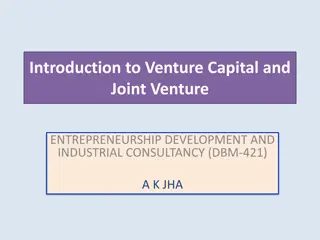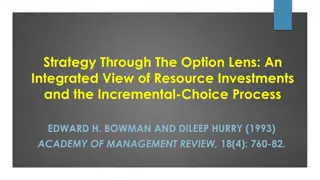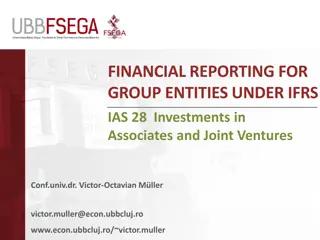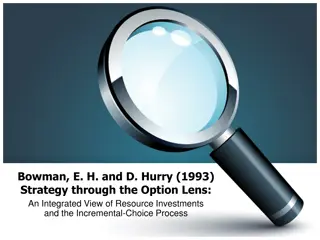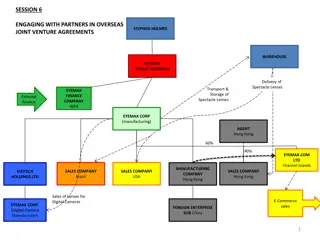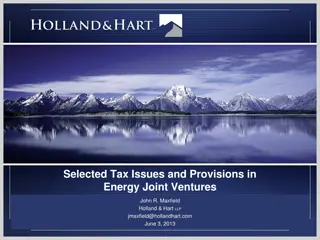Real Options in Joint Ventures: A Strategic Perspective
Explore the concept of real options within joint ventures, where firms can leverage economic opportunities to expand and grow in uncertain markets. This strategic approach involves waiting before investing and acquiring skills through partnerships, leading to better decision-making regarding market entry and expansion. The value of joint ventures as real options lies in the ability to defer investment, acquire necessary capabilities, and potentially outperform traditional market acquisition strategies.
Download Presentation

Please find below an Image/Link to download the presentation.
The content on the website is provided AS IS for your information and personal use only. It may not be sold, licensed, or shared on other websites without obtaining consent from the author.If you encounter any issues during the download, it is possible that the publisher has removed the file from their server.
You are allowed to download the files provided on this website for personal or commercial use, subject to the condition that they are used lawfully. All files are the property of their respective owners.
The content on the website is provided AS IS for your information and personal use only. It may not be sold, licensed, or shared on other websites without obtaining consent from the author.
E N D
Presentation Transcript
Joint Ventures and the Option to Expand and Acquire Bruce Kogut (1991)
Theoretical Background Research Background: the decision to invest and expand into new product markets characterized by uncertain demand + The task of building a market position and competitive capabilities requires lumpy and nontrivial investments Real Option: Real investment in operating as opposed to financial capital; Option it need never be exercised. Joint Venture: through pooling resources of two or more firms, firms can build a market position and competitive capabilities beyond its own resources: not only risk/cost-sharing but also total investment saving In the event the investment is judged to be favorable: 1. Further commitment of capital partners renegotiation 2. The party placing a higher value on this new capital commitment buys out the other Timing: When it is desirable to exercise the option to expand is likely to be linked to the time when the venture will be acquired.
Research Questions To explain the governance choice of joint venture and its outcome by utilizing a real option perspective. To empirically test the link in the timing of the acquisition of joint ventures and of the exercise of the option to expand.
Real Options Joint ventures are real options, not in terms of the legal assignment of contingent rights, but, like many investments, in terms of the economic opportunities to expand and grow in the future. The value of any investment = cash flows stemming from assets as currently in place + those stemming from their redeployment or future expansion (the value of growth opportunities) Idiosyncratic valuation: As both the value of the assets in place and the option can be potentially affected by current assets and opportunities of the partner firms, the valuations of the venture will differ among the parties (spillover, complementary effects). : the current value of an uncertain state variable may be altered in the future
Joint Ventures as Real Options First Option: waiting to invest + Second Option: Option to expand It pays to wait before committing resources Prior investment commitment is necessary to have the right to expand in the future Through the joint venture, the buying party has acquired the skills of the partner firm and no longer needs to invest in the development of the requisite capability to expand into the targeted market Divesting firm: capital gains realization; may not have complementary assets Market vs Acquisition: the net value of purchasing the joint venture < = the value of purchasing comparable assets on the market. (better information & the gain in experience)
Timing of Exercise The acquisition is justified only when the perceived value to the buyer is greater than the exercise price. Financial options: held to full maturity; Real option: immediate exercise Why JV acquisitions happen once it is profitable to exercise the option? 1. the value of the real option is only recognized by making the investment and realizing the incremental cash flows. 2. the necessity to increase the capitalization of the venture invariably requires a renegotiation of the agreement, often leading to its termination Two key considerations of timing: the initial base rate forecast underlying the valuation of the business and the value of the venture to each party (or third parties) as realized over time. Hypothesis: The venture will be acquired when its valuation exceeds the base rate forecast.
Empirical Context Selective Cues and Market Valuation the acquisition of a joint venture as an irregular decision which responds to two time-varying specifications of the market cues The short-term annual growth rate An annual residual error from a long-term trend Acquisition and Value of Assets in Place Divergent motivations to joint venture the present value of the assets in their current use vs the option to expand or redeploy share scale economies, coordinate the management of potentially excess capacity, and so on Why do the parties not agree to an immediate acquisition? (1) Learning considerations(Divesting party is contracted to pass on complex know-how on the running of the business & slow an erosion in customer confidence) (2) Pre-emption considerations (not divest to prevent other competitors to acquire)
Methodology Data were collected from both questionnaire and archival sources. 140 joint ventures with at least one American partner; 92 manufacturing Dependent variable: Acquisition: dummy variable Independent variable: Three dummy variables (R&D, Production and Marketing): indicating whether the venture included any of these activities. Concentration: four-firm concentration ratio at the four-digit SIC level Two selective cues: Annual Growth and Annual Residual Error
Results In concentrated industries, joint ventures appear to be used as an intermediary step towards a complete acquisition. Ventures with R&D activities or marketing and distribution activities are more likely to be acquired. Managers are sensitive to a long-term intra-industry base rate, which serves as a standard by which to evaluate annual changes.





